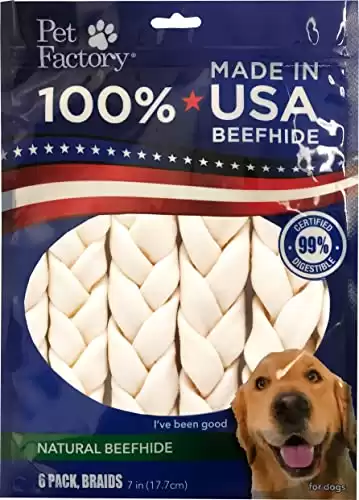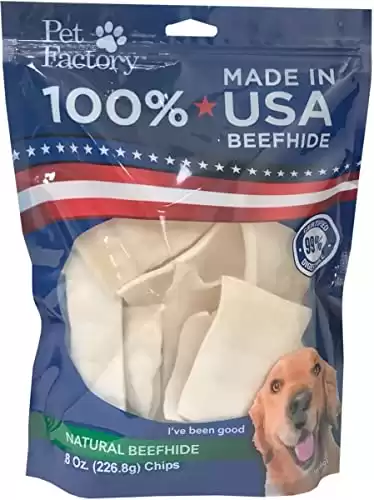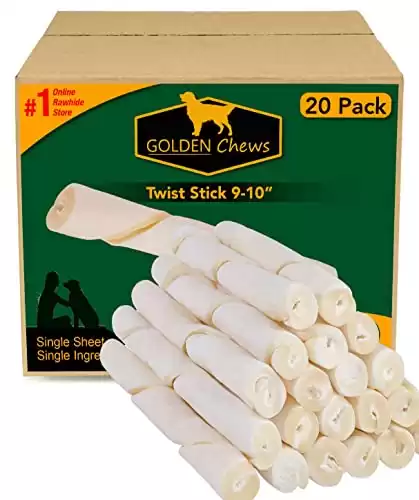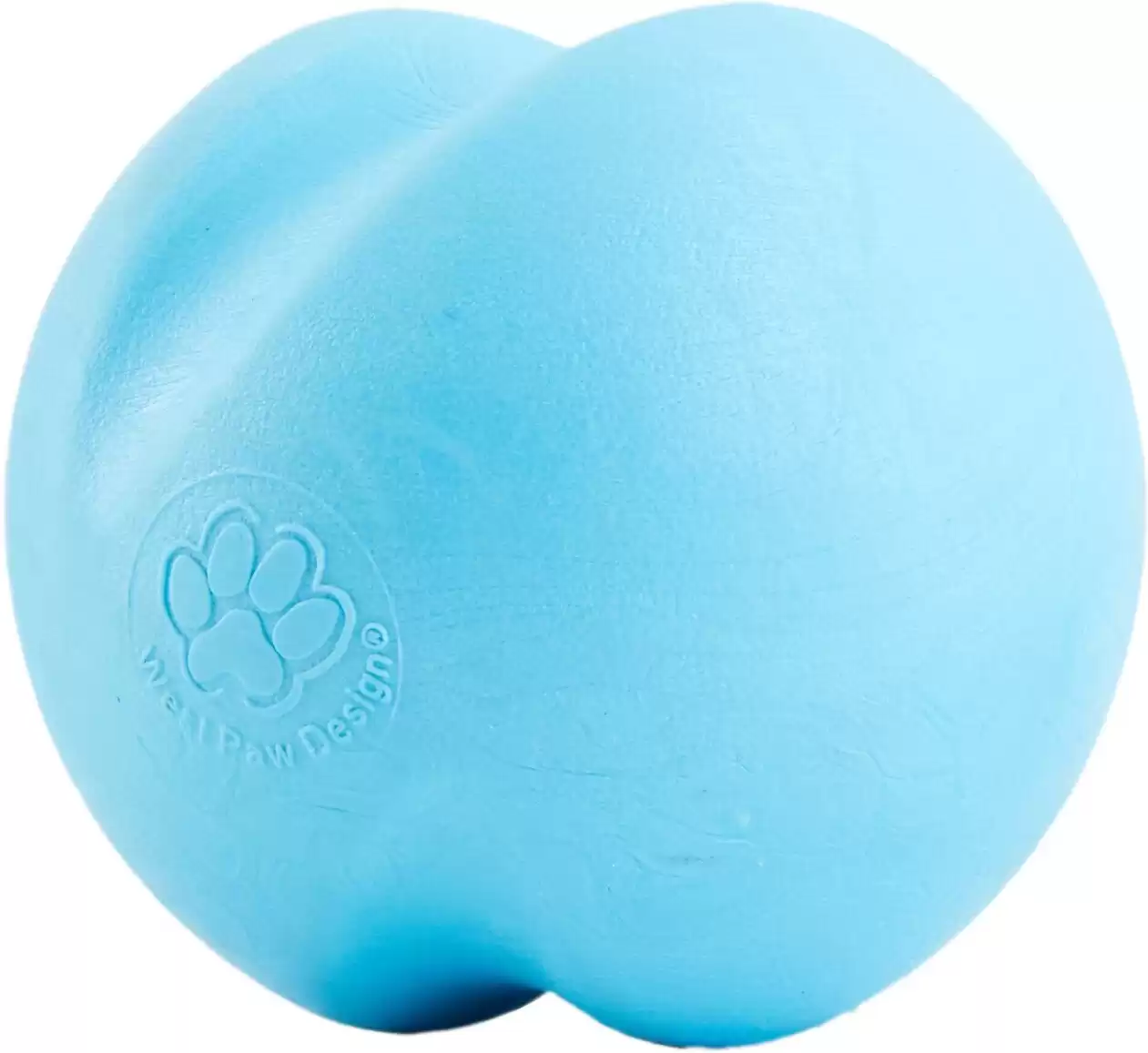It’s a quick, convenient, and (fairly) mess-free treat for your pooch, but is rawhide bad for dogs? It can contain both bacteria and chemicals and presents a choking hazard under some circumstances. Quite rightly, dog owners are far more interested than they used to be in what their dog is eating. Dog Moms and Dads now have a clear understanding of how what a dog eats can affect their health and well-being. Here we help you weigh up the pros and cons of giving your pooch rawhide chews so that you can do what is best for them. We also set out how you can minimize the risks that rawhide chews present to some dogs.
What Is Rawhide Made From?
Rawhide is the inner soft layer of animal skin. It is left over after the leather-making process which uses the tougher outer skin. In theory, any animal could be used to make rawhide but it is usually made from cattle. Some rawhide products, particularly imported ones, use the skins of pigs, sheep, and horses.
Rawhide is used as a chew for dogs. When you buy it, the rawhide will be dry and hard but as your dog chews it, their saliva and the grinding action of their teeth soften it. This allows them to tear off small pieces which they swallow.
How Is Rawhide Produced?
This varies between countries. In the US, it is usually transported to the factory under refrigeration to prevent spoilage and then processed to remove hair and fat using an ash-lye solution. Following this, it is cleaned with water and/or bleach before drying or smoking.
However, in some other countries, it is treated with chemicals (high salt brines) before transportation and may even be treated with arsenic or formaldehyde at the factory.
Why Do Dogs Love Rawhide?
You probably already know that dogs adore rawhide treats but why is this? It probably dates back to when dogs were given inedible scraps of human food from campfires. It was an early method of building engagement and kept the dogs loyal.
Dogs love to chew. As pups, they use it as a method of exploring their surroundings and it helps to ease the discomfort of teething. Adult dogs continue to chew as it forms part of their scavenging instinct and chewing on tough objects helps to clean their teeth.
Chewing is not always a positive thing though. Dogs sometimes chew things around the home because it gets them attention. Even getting told off (negative attention) is preferable to being ignored when you are a dog! Other dogs chew to relieve boredom or anxiety.
Why Give Rawhide To Your Dog?
Dogs have been given rawhide to chew for hundreds of years. Here are the main reasons that you may want to give rawhide chews to your dog.
- Rawhide is a convenient way to satisfy your dog’s urge to chew. It can be a useful way to direct their chewing behavior away from your door frames and shoes!
- When rawhide chews are consumed safely, they are good at scraping plaque off a dog’s teeth. This helps to maintain their dental health.
- Compared to some other chews, rawhide products are relatively inexpensive and this makes them attractive to many owners.
What Are The Potential Dangers Of Rawhide Chews?
Rawhide can be a controversial subject amongst dog owners and opinions are divided on whether they are healthy for dogs. Here are some of the potential problems with rawhide:
- Some rawhide products have been produced using strong chemicals and these may remain in the chew. The effect of these chemicals on a dog’s health is not completely understood. You can get around this to some extent by researching how and where the product was produced.
- Rawhide chews are natural products produced from the carcasses of animals. Therefore, they can be contaminated with bacteria that can cause disease in both dogs and humans. Always wash your hands after handling them.
- Some drier rawhides (these are the poorer quality products) can break a dog’s tooth. This is painful for your dog and expensive for you to rectify.
- Flavors are added to some rawhide products. If these are artificial chemicals, they can cause adverse reactions such as vomiting in sensitive dogs.
- Rawhides that are too small for your dog can present a serious choking hazard.
- Some dogs choose to swallow large chunks of rawhide whole! This is not a good idea because it can cause blockages in the intestine. Surgery will be needed to remove them.
What to Look for in Rawhide Products
You can take advantage of all the good things that rawhide offers and limit the dangers at the same time by doing your research and choosing the right product. Here’s what you should look out for.
How were the animals raised?
The welfare of the animals used to make the rawhide has a bigger influence on the quality of the product that the type of animal they were. Look for information on how the animal was treated and what conditions it was reared under. Free-range animals and those raised organically will produce a thicker rawhide that is safer for dogs to chew on.
Where was the rawhide produced?
Rawhide produced in the US is more expensive but is produced using fewer chemicals than those produced in some other countries. Many rawhide chews are produced in China and it is thought that the animal skins are stored for months before they are processed. Some decay will inevitably take place so the AKC recommends that you rinse them in water before giving them to your dog.
Avoid flavored products
If you choose an all-natural rawhide chew that has no artificial additives, it is much less likely to upset your dog’s stomach. We know that dogs love the artificial flavors of rawhide products but that does not mean that they are good for them.
- Made from totally natural ingredients
- Very easy digestible
- Longer lasting chews
- Good for dogs with sensitive stomachs
Choose the Correct Size
Larger dogs need larger treats! Rawhide that is molded into a long and cylindrical shape and made from thick pieces of hide is safer for your larger dog. Any shape that has small pieces that can break off is potentially dangerous.
- Made from prime beef hide
- Vet-recommended
- Remove tartar
- Made of a full grain material
How Often Can Dogs Have Rawhide?
Not very often to begin with. You will need to monitor if they have a reaction. Then you can give them once or twice a week as a treat. Smaller dogs can only have smaller quantities. Your vet is the best person to give you advice on how much rawhide is safe for your dog.
You can reduce the risks associated with rawhide by giving only one chew at a time and monitoring any adverse reactions. Do not give rawhide to your dog when there are other dogs around as this encourages them to gulp it! Once the chew is small enough to swallow – remove it!
What to Do if Your Dog Swallows Rawhide
If you are certain that your dog has swallowed a large piece of rawhide, contact your vet for advice. If you choose to give rawhide to your dog, watch out for signs that something is wrong. This includes gagging, choking, vomiting, fever, difficulty breathing, and diarrhea. Contact your vet immediately if your dog develops these symptoms.
Rawhide Alternatives
If you decide that rawhide is not something that you want to give your dog, there are alternatives. Interactive toys will keep them amused and stimulate their brain at the same time.
Many owners choose nylon chews as an alternative. They are (usually) indestructible and come in all sorts of shapes and flavors. You could also try fishskin sticks but they do have a strong fishy odor!
- Made of recycled materials
- Dishwasher safe for easy cleaning
- Floats in water — great for water play
- Made in the USA
- Latex-free and FDA-compliant
Is Rawhide Bad For Dogs?… The Bottom Line
Yes, under some circumstances rawhide can be bad for dogs but don’t we humans enjoy some things that are bad for us too? Provided you are careful about choosing the best product for your dog and you supervise them correctly, the risks can be minimized for most dogs. They will benefit from satisfying their instinctive need to chew and it will keep them occupied for half an hour or so! However, if your dog has a habit of gulping large pieces and gagging and choking on them, you would be advised to try an alternative.
The photo featured at the top of this post is © MaxShutter/Shutterstock.com
Ready to discover the top 10 cutest dog breeds in the entire world?
How about the fastest dogs, the largest dogs and those that are -- quite frankly -- just the kindest dogs on the planet? Each day, AZ Animals sends out lists just like this to our thousands of email subscribers. And the best part? It's FREE. Join today by entering your email below.
FAQs (Frequently Asked Questions)
Is rawhide a natural product?
Yes, it is a natural product but many rawhide chews have had a lot of industrial processes inflicted on them before they reach your dog’s mouth. Just because something is natural, does not mean that it is healthy. There are a lot of chemicals used in the production of some rawhide products. Also, some have artificial flavors added to make them more attractive to dogs.
Can puppies have rawhide?
Pups over six months of age can enjoy rawhide and will enjoy chewing it. However, they must be supervised closely. Start by giving one chew and monitoring closely to see if there is a reaction.
Do I need to supervise my dog with rawhide?
Yes, dogs should always be supervised when they are given a rawhide chew. There is a real danger that your dog could choke on a piece that breaks off from the chew. Large pieces can also cause intestinal blockages if they are swallowed.
Can dogs digest rawhide?
Large pieces of rawhide cannot be digested by a dog’s intestines. Therefore, if your dog has swallowed a large portion, it could be as serious as if they have swallowed a sock or a part of a shoe. Smaller pieces are usually broken down in their gut within 24 hours.
Thank you for reading! Have some feedback for us? Contact the AZ Animals editorial team.











